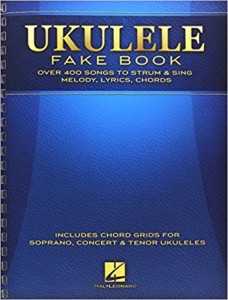By: Russ
Aloha! Are you familiar with fake books? The way that it was explained to me, years ago, was that it was basically just a memory jogger. You would learn songs – lots of songs – and then you would forget the chord progressions. You would know the rhythm and melody but would forget the chords because you know so many songs with so many chords. So you make a fake book with the chord progressions like so:
“Fake song”
Verse
C, A, C, D
Chorus
F, A
And boom, there’s your fake book. You could cram a ton of songs into a relatively small package like a binder or notebook and bring it to gigs in case people call out songs you know, but don’t REALLY remember.
But that’s only one type of fake book. Another type is Hal Leonard’s which I’m pretty sure is just the sheet music for songs that includes lyrics and chord boxes for ukulele. Not that this is a bad thing, mind you. I honestly think that it’s called a fake book because there’s just so many offerings from different genres, styles, and decades. There really is a little bit of everything in this for you and it’s all laid out in basic form for easy understanding.
The best thing about this book is the size. There are over 400 songs included in this ONE book and THAT is amazing. To illustrate just how amazing it is, the other night I was watching a Nostalgia Critic review on YouTube (because it’s a very funny show) and he referenced “Rainbow Connection.” I thought about it and said to myself “yeah, I bet that would be a fun song to play!” I opened the Ukulele Fake Book and there it was on page 454. I also flipped through from the beginning on and found songs that I love but never thought to learn on ukulele. “Time of Your Life,” “At Last,” a bunch of Elvis songs, “Dream Lover,” “Blue Bayou,” and on and on and on. Even songs that I would totally learn just for laughs is in here (Smash Mouth’s “All Star”).
That’s the beauty of the book.
The downside is that it’s a massive book. I mean, over 400 songs has to fit in SOMEWHERE, but the book is larger than most of this year’s phonebooks at 686 pages. This would obviously cut down on the portability, but you could always copy the chord progressions and bring them with you if you knew what the set would include.
Fortunately, Hal Leonard gives the buyer a choice: you can buy this behemoth or you can buy a smaller version. The songs are exactly the same, written exactly the same, they’re just written smaller. If you’re looking for portability, that might be your best bet, but if you’re looking for legibility – particularly on stage looking down at a book – the bigger version might be more up your alley. I look at it like this: If you’re staying home and using it, get the smaller one because it’s easier to handle (also slightly cheaper), but if you’re going to be bringing this out, the big one will be better. Less wieldy but more visible.
The book is bound nicely WITHOUT spiral binding. I hate spiral binding. It does lay flat, which is nice, but it’s easy to spin around and break the edges and then you have to deal with torn holes as it slowly (but surely) begins to rip apart from one end to the other. This comb binding is a nice compromise between stitched or stapled binding and spiral binding, though. It lays flat, but you can’t twist it too far since it’s a piece of plastic with multiple termination points as opposed to one continuous spiral. And on the side of the plastic it even says what it is so it’s even easier to find on your shelf.
Personally, this is my favorite musical book I’ve ever reviewed. I would think of songs and look them up and, yup, there they are. This is INVALUABLE! I could easily think of hours spent trolling the internet looking for accurate chords for different songs, clicking out of pop-up ads, dealing with pushy “subscribe!” notices, or risking malware on my computer and now, I can just open the book and it’s probably right there!
And, for the amount of songs, it’s really affordable. There are other ukulele fake books that I will review later, but it makes me wish there were more treasure troves like this. Hal Leonard has a Disney Fake Book, for instance, that I would LOVE to see in ukulele transcriptions. There’s also a Sinatra Fake Book, a Coffeehouse Companion (which sounds particularly interesting) – oh my god, they even have an Easy Jazz Fake Book. Why are these not available in ukulele? I would buy them all!
But I would START with this book. If you’re looking to learn ukulele, the bang for your buck value here is out of this world. I can’t recommend it enough!
Until next time! Mahalo!
